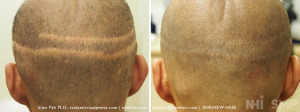First, please read the article from the Associated Press here: Wife Files Suit After Husband’s Dies During Hair Transplant Operation.
—
 Here’s my in-depth 2 cents:
Here’s my in-depth 2 cents:
This is a tragic and unnecessary death and my heart goes out to the family. According to the article, this actually occurred a year ago today (April 27, 2006), but the case was just filed in Los Angeles Superior Court, and thus made public. From what I could get out of the court filing I read, there was an overdose of some medication (I believe it was Lidocaine) and the response of the professionals in attendance was inadequate to address either the medication that was overdosed or the proper management of the critical emergency with basic life support activities. Why did it happen? Is it a real risk for people wanting to undergo a hair transplant procedure? Are hair transplant procedures any more risky than other plastic surgery procedures or even a dental office procedure? These questions have been raised because of this news release and I would be remiss not to discuss this at some level of detail.
Why this happened is something that we will not know until all of the facts of this case are revealed in the legal proceedings, but I can tell you that I am unaware of any death other than this one (in anybody’s hands, anywhere in North America) that has occurred in the years since I have been a hair transplant surgeon (1991 to 2007). Hair transplantation, or any surgical procedure, has its greatest risk associated with the anesthetic used. If the patient only has local anesthesia, then the risks should be almost minimal, yet this patient apparently died from the simplest form of local anesthesia. But, like any medication, there are known risks of Lidocaine. eMedicine says, “If untreated, local anesthetic toxicity can result in seizures, respiratory depression or arrest, hypotension, cardiovascular collapse or cardiac arrest, and death.” This begs answers to questions which have not yet been posed. I am resolute in stating that local anesthesia is absolutely safe, provided that the person administering it does so in a competent manner. Tylenol, aspirin, vitamins, alcohol and other such substances should be absolutely safe, but on very rare occasions, each of these can kill. When used in ‘overdose’ and untreated, these medications (including Lidocaine) can be lethal.
How does an ordinary person know if the doctor he chooses, the facility the doctor practices in or the track record of the doctor’s previous history is ‘clean’? You can go to the medical board of the state and find out if the doctor has a clean record (available online in most states). You might be surprised to find that your doctor has been in trouble and has a well ‘marked up’ record of infractions. Doctors who are known drug addicts, who had sexual misconduct, or who have been disciplined by the medical board for any reason, create a public record which you can get access to. If the doctor practices in a certified surgical facility or hospital, you can assume that the doctor’s work is overviewed by a ‘peer review’ process which holds the doctor accountable for his actions and his surgical results. Doctors who confine their work to their offices or those who do not seek out national certification and peer review are not accountable to an official ‘body’. Just because they are not reviewed by impartial third parties does not necessarily mean that these doctors aren’t any good. It means more that those doctors who are reviewed and are held accountable for the quality of the medical care they administer, may reflect upon the style of their practice which is open for criticism by accrediting organizations. I personally welcome such a review, as it gives me a check on my own personal belief that I am doing everything possible to deliver the best medical care that I can. Had I unknowingly used doses of medications that were dangerous, for example, the reviewing physician who checks my use of medications during an inspection would have identified a problem in my drug use routine and notified me of the need to re-examine what I was doing.
Sudden death:
People die in their sleep, when exercising, running a race, working under stress, having sex, going to the toilet, etc. Many of these spontaneous deaths are caused by a heart rhythm problem where a heart stops beating from something called spontaneous ventricular fibrillation (SVF). As this can happen anywhere and at any time, each of us should be prepared to act, to save a life, because that life could be your father’s or mother’s or your child’s. The EMS (or EMT or paramedics) know how to maintain an open airway, administer cardiac massage and perform more advanced life support, which would be appropriate in such SVF situations. Many lay people are also trained at performing cardiac and airway life support at the most basic level and death can be delayed and possibly prevented as more sophisticated care is administered. For those of you reading this, you should be able to perform basic life support services just in case someone near you undergoes SVF. This means that you can pump a chest (perform external cardiac massage) in a person whose heart stopped and you can administer respirations while keeping the airway open. Simply calling 911 (at least in the US) can bring you sophisticated life support services (in most cities) within 5 minutes. We should expect that your doctors, nurses, medical technicians and every person working in your medical office will know the fundamentals of at least basic life support. Certainly, when a doctor gives any anesthesia, that doctor must be able to manage a worst case scenario and direct the entire process where life support services meet the standards of care for a medical facility. That doctor should also be intimately familiar with the drugs he/she uses, in case some rare side effect should occur.
If what was reported in the case filing of this death is correct, the doctor and all of the support people on his staff failed to meet the fundamental standards for basic cardiac life support. Still worse, is the suggestion that the responsible medical personnel may not have been what the patient who died had expected. John Lord (referred to as a “doctor” in the court action) is not a medical doctor. I personally have complained to the Medical Board of California on a number of occasions about Mr. Lord’s activities that were reported by ‘patients’ of his, his credentials, and his practice. Anyone can check online records to find that there is no licensed MD or DO named John Lord in California and the suggestion that he was a licensed physician performing surgery as claimed in the civil suit purports possible criminal activity [Update: John Lord plead guilty to a felony count of practicing without a license]. Many things are claimed in the legal action, much of which (if proven in court) makes this case unique and beyond a simple case of malpractice. If he was a doctor, Mr. Lord could be tried for malpractice — but he’s not. Does that mean that this is a matter for the ‘state’ attorney and if so, is it a criminal matter (practicing medicine without a license)? We must, of course, let the legal process work its course and basic to the constitution, these defendants are innocent until proven guilty. But the more basic question that must be asked is, “What is being done to protect the public now if these accusations are proven true in the months or years yet to come?”
I have reviewed the medical literature on the subject of death in a doctor’s and dentist’s office to try to find out what the experience has been across the United States. None of the improprieties of possible criminality are discussed in the brief review I have put together here. I have focused on the data which address the risks of death in an outpatient setting. Florida, Oregon, and Texas have provided a review of some of their experience over many years. These reviews, in part, have included dental office procedures as well. Most patients who died had preexisting conditions, such as gross obesity, known cardiac disease, epilepsy, chronic obstructive pulmonary disease, and liver disease that can significantly affect anesthesia dosage and care. In the dental office, while under sedation/anesthesia, insufficient or inadequate oxygenation arising from airway obstruction and/or respiratory depression was the most common cause of life threatening events. In all of these cases most of the adverse events were determined to be avoidable with skilled medical care. When age is factored into the risk formulae, risks go up significantly in patients who fall outside the healthy, young adult category typically treated in the surgical/dental outpatient setting. In the death under discussion here, the patient appeared to be a healthy man, so his risk of death should have been negligible.
In the state of Florida (over a 6 year span), a total of 46 deaths related to office procedures were reported. Twenty of those were “plastic surgery procedures” and 11 people died in the immediate treatment period (first 24 hours). The most common cause of death reported were from blood clots (most probably from the legs). Most of the deaths involved non-board certified plastic surgeons. The 46 deaths were among over 600,000 surgeries. This puts the risk at 0.00077 of patients. Unfortunately, the one who dies has a risk of 100%.
44,000 Americans reportedly die annually as a result of medical errors. Medical mistakes are the eighth leading cause of death in the United States. When surgery is performed in an office-based setting, the risk for serious injury or death comprises a 10-fold increase when compared with a certified ambulatory surgical facility. At the New Hair Institute, we have maintained a certified ambulatory surgical facility since 1996. I am proud to say that we may be one of very few hair transplant centers that is fully AAAHC (Accreditation Association for Ambulatory Health Care) accredited. To be accredited and certified, the doctor and facility must meet the highest standards for safety, cleanliness, and the use of proper standardized procedures. The facility must undergo inspections by highly trained physician specialists to determine (by independent medical record review) that all of the standards are met, and that the complication rates (infection and surgery) fall within national standards. The doctors and staff must be trained in life support and at least one physician must be trained in Advanced Cardiac Life Support (all of our doctors are so trained). I must reflect on the Hippocratic Oath: primum non nocere (“first, do no harm”). Patient safety must be the foremost priority in any surgical procedure and that means:
- That the doctors are trained and retrained at least every two years in Advanced Cardiac Life Support (ACLS) and know how to respond to emergencies.
- That the doctors fully understand the risks of what they do and all of the potential complications of the medications that they administer and how to respond to such complications.
- That the doctors and their entire staff are adequately trained in the procedures that they perform and oversee, including life support activities.
—
Update on Friday Evening, April 27th:
ABC News just announced that John Lord plead guilty to a felony for practicing medicine without a license.


 Here’s my in-depth 2 cents:
Here’s my in-depth 2 cents: